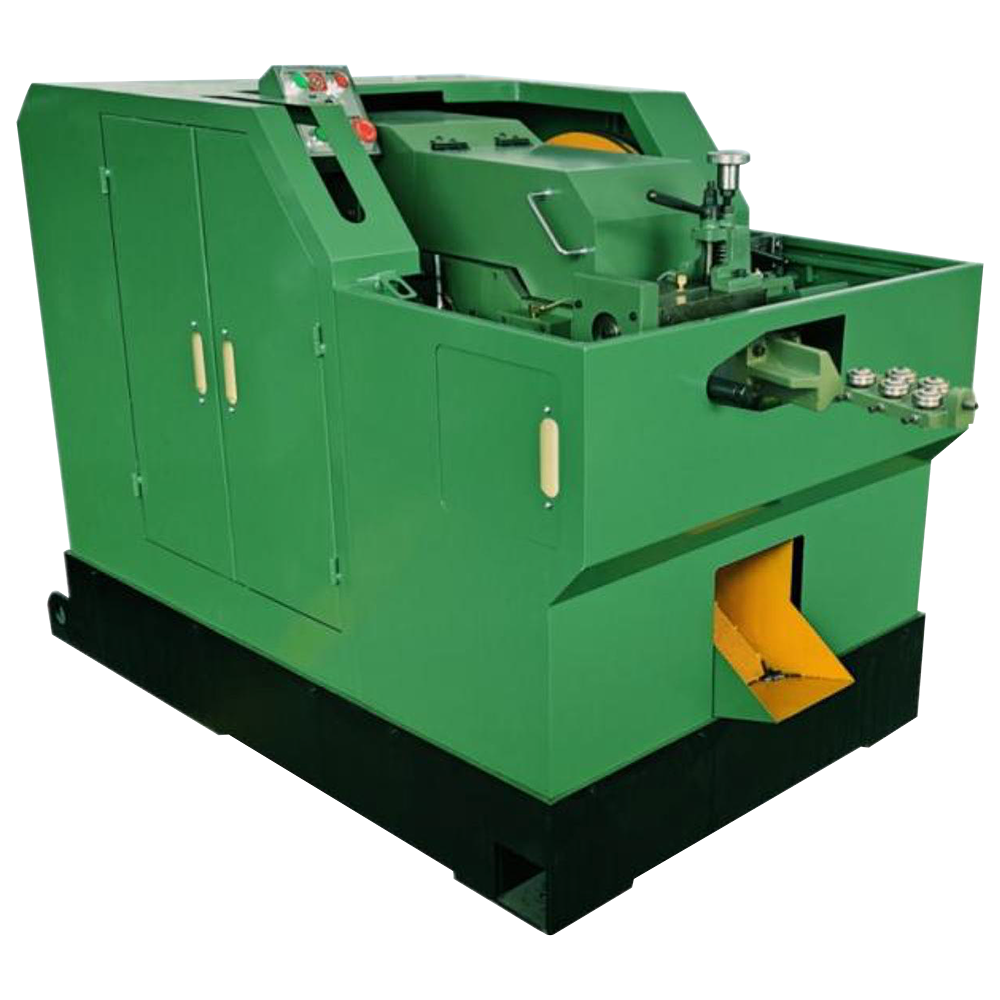제조업계에서 정확도는 단순한 유행어가 아닙니다. 부품이 허용 오차를 충족하지 못하면 조립 라인에서 잼이 발생하거나 배치가 불량으로 처리될 수 있으며, 더 심각한 경우 안전 문제가 발생할 수도 있습니다. 그래서 사람들이 물어볼 때"멀티 스테이션 콜드 헤딩 머신은 정확한가요?"짧은 대답은 '예'이지만, 항상 그렇듯이 전체 그림은 조금 더 미묘합니다.
콜드 헤딩은 효율성뿐만 아니라 매우 일관된 부품 치수를 제공하는 능력으로도 잘 알려진 공정입니다.멀티 스테이션 머신한 걸음 더 나아가 보겠습니다. 이 글에서는 이러한 맥락에서 '정확도'가 실제로 무엇을 의미하는지, 이러한 기계가 어떻게 정확도를 달성하는지, 무엇이 영향을 미칠 수 있는지, 그리고 애플리케이션에 이러한 수준의 정밀도가 필요한지 살펴봅니다.

콜드 헤딩의 정확성에 대해 이야기할 때, 단순히 볼트가 볼트처럼 보이는지 여부에 대해 이야기하는 것이 아닙니다. 치수 공차, 형태 일관성, 반복성 등 최종 사용 시 부품의 적합성, 기능, 견고성 여부를 결정하는 모든 요소에 대해 이야기하는 것입니다.
치수 정확도는 완성된 부품의 실제 크기가 의도한 설계에 얼마나 가까운지를 의미하며, 일반적으로 밀리미터 단위로 측정됩니다.
양식 정확도는 특히 여러 단계로 부품을 성형할 때 헤드 프로파일, 홈, 테이퍼 등 복잡한 형상의 균일성을 유지하는 데 중점을 둡니다.
반복성대량 생산의 핵심은 기계가 본질적으로 동일한 부품을 10만 개나 만들 수 있는가 하는 것입니다. 그렇지 않다면 처음 몇 개의 부품이 어떻게 생겼든 '정확'하다고 할 수 없습니다.
콜드 헤딩의 특징은 절삭이 아닌 힘으로 금속을 성형한다는 점입니다. 기본적으로 금속을 고압으로 다이 캐비티로 이동시키는 것입니다. 따라서 기계 가공보다 변동성이 적지만, 재료 흐름부터 금형 정렬까지 모든 것이 중요한 역할을 합니다.
놀랍게도 많은멀티 스테이션 콜드 헤딩 머신만큼 엄격한 허용오차를 달성할 수 있습니다.±0.01 ~ ±0.05 mm이는 절단이 아닌 성형 공정의 특성을 고려할 때 인상적인 수치입니다. 이러한 수준의 제어는 몇 가지 엔지니어링 이점에서 비롯됩니다:
단계별 성형: 멀티 스테이션 기계는 모든 것을 한 번에 성형하는 대신 공정을 여러 개의 정밀한 작업(셋업, 헤딩, 압출, 트리밍 등)으로 세분화합니다. 이러한 점진적 접근 방식은 변형 오류를 최소화합니다.
견고한 기계 설계: 이 기계는 탱크처럼 제작되었으며, 그럴 만한 이유가 있습니다. 구조적 안정성이 진동을 최소화하여 정확한 공구 정렬과 일관된 힘 전달을 유지합니다.
정밀 금형 및 펀치: 고품질 콜드 헤더의 툴링은 고급 텅스텐 카바이드 또는 이와 유사한 재료로 제작되는 경우가 많습니다. 마이크로미터 수준의 정밀도로 정밀하게 연마되고 장착됩니다.
최신 컨트롤: 고급 콜드 헤더에는 서보 공급 시스템, 디지털 다이 포지셔닝 및 오류 감지 센서가 함께 제공될 수 있습니다. 이는 정확도뿐만 아니라 사람이 지속적으로 조정하지 않아도 일관성을 유지할 수 있다는 것을 의미합니다.
하이엔드 자동차 및 항공우주 제조업체가 미션 크리티컬 부품을 위해 이러한 기계에 크게 의존하는 것은 우연이 아닙니다.
심지어 가장고급 콜드 헤딩 머신는 프로덕션 현실에 영향을 받지 않습니다. 정확도는 시간이 지남에 따라 변동하거나 다양한 요인으로 인해 설정에 따라 달라질 수 있습니다.
가장 많이 움직이는 경향이 있는 것은 다음과 같습니다:
도구 마모
금형과 펀치는 마모가 심합니다. 마모되면 치수 정확도가 떨어지기 시작합니다. 그렇기 때문에 사전 예방적인 공구 모니터링과 교체 일정이 중요합니다.
자료 불일치
와이어 경도나 직경에 약간의 차이가 있으면 특히 멀티 스테이션 성형에서 재료 흐름이 고르지 않을 수 있습니다. 인증된 재료와 입고 검사는 이를 방지하는 데 도움이 됩니다.
정렬 오류
금형이 완벽하게 정렬되지 않거나 가이드웨이가 마모되면 완성된 부품에 점진적인 모양 왜곡이나 깜박임이 나타납니다.
부적절한 윤활
콜드 헤딩은 열을 사용하지 않지만 마찰은 여전히 요인이 됩니다. 윤활이 제대로 이루어지지 않으면 미세한 찢김, 표면 결함 또는 고르지 않은 성형 압력이 발생할 수 있습니다.
연산자 오류
이러한 기계는 정밀하지만 완전히 자율적이지는 않습니다. 숙련된 기술자는 설정, 보정 및 지속적인 조정에서 큰 차이를 만들어냅니다.
요컨대, 매우 정확한 기계를 구입할 수 있지만 정확하게 실행해야 합니다.
많은 제조업체가 간과하는 부분입니다. 모든 애플리케이션에 ±0.01mm의 공차가 필요한 것은 아닙니다. 특히 툴링 비용을 줄이거나 공격적인 사이클 타임을 달성하는 것이 목표인 경우에는 "충분히 근접"하는 것만으로도 충분할 때가 있습니다.
대략적인 가이드는 다음과 같습니다:
| 애플리케이션 | 필요한 정밀도 수준 |
| 자동차 안전 부품 | 매우 높음(±0.01-0.02 mm) |
| 전자 제품(예: 커넥터 핀) | 매우 높음(±0.005~0.01mm) |
| 소비자 패스너 | 보통(±0.05~0.1mm) |
| 가구/건축 부품 | 낮음(±0.1mm 이상) |
자동차 엔진용 나사산 패스너를 생산한다면 물론 그런 종류의 정밀도가 필요합니다. 하지만 가구 프레임용 범용 볼트를 성형하는 경우라면 어떨까요? 마이크로미터 제어 기능이 있는 6 스테이션 콜드 헤더가 필요하지 않을 것입니다.
제품의 허용 오차 범위를 이해하면 사용하지도 않을 기계 기능에 과도하게 지출하는 것을 방지할 수 있습니다. 따라서멀티 스테이션 콜드 헤딩 머신은 정확합니까?당연하죠. 특히 복잡한 부품을 일관되고 비용 효율적인 방식으로 생산할 수 있는 가장 정밀한 대량 금속 성형기 중 하나입니다.
즉, 정확성은 기계에만 국한된 것이 아닙니다. 시스템입니다. 기계의 잠재력을 최대한 발휘하려면 올바른 원자재, 고품질 툴링, 숙련된 설정, 정기적인 유지보수가 필요합니다. 이러한 요소들이 한데 어우러지면 공차가 엄격한 부품을 안정적이고 반복 가능하며 빠르게 생산할 수 있습니다. 하지만 잊지 마세요: 정밀도는 목적과 일치해야 합니다. 기계가 얼마나 정확한지뿐만 아니라 얼마나 정확해야 하는지 스스로에게 물어보세요.